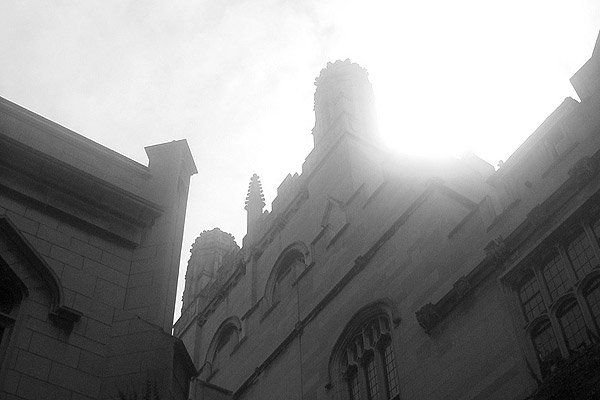
I haven't had any thoughts about Trayvon Martin that haven't been expressed in the all-points coverage that the incident has received—if it was flagging, it's destined to pick up again, now that George Zimmerman has gone AWOL on his lawyers in lieu of talking to Sean Hannity. But it did remind me the best essay I've ever read on Chicago, or at least my favorite.
It's called "Mr. Bellow's Planet," and it was adapted from Parallel Time, the 1994 autobiography of New York Times editorial board member and author Brent Staples. He has roots where I grew up, and earned two graduate degrees from my alma mater, the University of Chicago, so I took immediately to it. I'd even read it before I moved to Chicago, as it appeared in the brilliant anthology Literary Journalism, which had a tremendous impact on my future, and may have played some small role in my choice of universities. (Staples's essay isn't online, but a couple of the vignettes in it come from his Ms. Magazine essay "Black Men in Public Spaces." "Mr. Bellow's Planet" is much better, though.)
"Mr. Bellow's Planet" is not, on its face, an appealing pitch for Hyde Park. Much of the essay is about how cold and bleak the neighborhood can be, and how difficult it is to get out of it, which he captures perfectly:
By nightfall I was crazed with cabin fever. I decided to go to the movies. This meant taking the el to the North Side, to the Biograph Theatre. The trip was punishing, especially with the Jackson Park el on its Sunday schedule. A wait of forty minutes was not uncommon. Some el platforms offered the mercy of enclosed waiting areas. But mainly you stood in the open while the guillotine winds cut you to pieces.
By the time I got there, the Jackson Park el stop was gone, and going out at night required a Red Line ride out to 55th or 63rd, followed by a long wait over the Dan Ryan for a bus. But as hard as Hyde Park can be, it can be worth the cold:
The cold slipped its knife through the bathroom window and cut you as you showered. Outside, the storm drains along the street vented steam, as though boiling. As you walked to the corner store, steam flared from your tearducts and from the surface of the eye itself.
The beauty of the nights compensated for this cruelty. The wind that punished had also swept the sky clean and left it breathtakingly clear.
Having moved out of the neighborhood, I find myself spending less time outside during the depths of winter, even though Hyde Park—with the wind tunnel of the Midway—is one of the hardest places to spend it in the city. The stillness of Hyde Park on a winter's night sometimes brought me peace, as it did for Staples, but it has its origins in a troubled past, when the University displaced 30,000 people, applying the abstract lessons it had famously developed as a hub of urbanism to its own backyard.
Another hardness of the neighborhood is the stark divide between Hyde Park and Woodlawn. Staples lived right on the line, as I did for a year, and saw heroin buyers "queued up on Ingleside Avenue with blinkers flashing, like planes awaiting takeoff at O'Hare…. On my side of 61st you couldn't sneeze without arousing suspicion."
Though Staples arrived at the University of Chicago almost two decades before me, everything in his portrait of it is hauntingly familar. Except his experience of it as a young, tall black man.
The story that's been pieced together about the shooting of Trayvon Martin: Zimmerman followed Martin around the neighborhood, alerting the cops but not following their instructions to back off. Then something happened between Martin and Zimmerman. Allegedly a physical altercation took place; allegedly Zimmerman was hurt. Then Martin was shot. It immediately calls to mind visions: for Charles Blow, who is black, fears about his children's safety; for John Derbyshire, who is white, fears for his own.
I immediately thought of Staples, who would hear the clicks of car locks as he walked through the neighborhood I'd live in one day, and who, for awhile, would whistle Vivaldi or the Beatles to allay the fears of passers-by. Then something changed.
One night I stooped beneath the branches and came up on the other side, just as a couple was stepping from their car into their town house. The woman pulled her purse close with one hand and reached for her husband with the other. The two of them stood frozen as I bore down on them. I felt a surge of power: these people were mine; I could do with them as I wished. If I'd been younger, with less to lose, I'd have robbed them, and it would have been easy…. I thundered, "Good evening!" into their bleached-out faces and cruised away laughing.
Another thing that resonated from Staples's story was that he arrived in the metropolis from a small city to the east, equally wide-eyed and innocent at about the same age; Staples was 22, I was 21. He was awed by the lake: "the first lake I'd known whose opposite shore was not seeable with the naked eye." He blew off O-week and ended up in the wrong neighborhoods: "Since I'd skipped the tours and lectures to wander on my own, I was ignorant of geography and danger." And like me—but from the other side of the street—he learned about the fearsome power of racial identity, and how tempting it is to wield when you're afraid.
Photograph: smaedli (CC by 2.0)



Comments are closed.